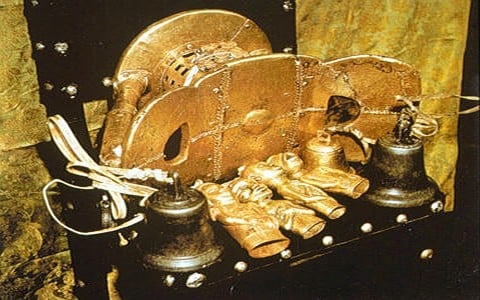The period that lasted from the late 18th Century until the mid 19th Century is often labelled the Age of Revolutions. Visualizing this time period provokes images of the various revolutions of Europe and the Americas, and the likeness of George Washington, Simon Bolivar, Maximillian Robespierre.
In the West African Empire of Ashanti, the late 18th Century was also a time of revolution. In 1763, a crowd of bureaucrats, nobles, and common people alike convened in the empire's capital of Kumasi. There, they declared the impeachment of the current Asantehene, the elderly and unpopular Kusi Obodom. The crowd had many bones to pick with Obodom: his cession of power to provincial governors, his failed military record, and the general moribundity of his rule. In his place, the assembled citizens elected the energetic reformer prince, Osei Kwadwo.
 |
| Despite his unpopularity, Kusi Obodom was still given a traditional black funerary stool. His was kept separately from the other kings' stools though, and is thus not pictured here. |
Due to the many radical reforms implemented during his rule, as well as the fact that he was the first elected asantehene, the period of Kwadwo's rule would go down in history as the Kwadwoan Revolution. And revolutionary it was. By the time Kwadwo's reign ended, every aspect of Ashanti government had been radically transformed. While the asantehene had never been a true autocrat in practice, Kwadwo's reforms would significantly limit executive power, making the Ashanti Empire into a true constitutional monarchy.
The first area of government which Kwadwo reformed was the Kotoko, the cabinet of local kings that advised the asantehene on matters of state. The fact that local kings served on the Kotoko was vital for state stability, but was also somewhat of a relic of Osei Tutu's era. Promoting unity within the Ashanti state was still important, but the loyalty of the kings of Juaben, Bekwai, and Mampong was no longer the pressing issue it once was. In fact, having local kings in this important administrative system caused more trouble than it was worth. During the recent failed war against the Dahomey, the potential dangers of including unqualified nobles in government was made clear. Odankua, a constituent king on the Kotoko, performed poorly during the war, and his unwise decision making contributed to the Ashanti's defeat. Kwadwo did not abolish the inclusion of local kings on the Kotoko, but rather limited their role. In addition to the three kings, new positions filled by professional bureaucrats were added to the council. These included a designated minister of war, minister of finance, and governor of Kumasi. These positions were not hereditary, but rather appointed based on merit. Kwadwo also shook up the bureaucracy more generally, abolishing hereditary bureaucratic offices and replacing them with meritocratic positions.
However, the most pressing issue for Kwadwo to reform was the balance of power within the Ashanti government. For the last several decades, conflicts between the Nsafohene (national bureaucrats from Kumasi), and amanhene (provincial governors) had contributed to instability within the Ashanti state. At its worst, this feud had contributed to the civil war that brought Kusi Obodom to power. To reduce the potential instability of these conflicts, Kwadwo decided to create an alternative means for these two groups to settle disputes. He created a parliamentary body called the Asantemanhyiamu, or "Meeting of the Ashanti Nation." This parliament was attended by both Nsafohenes and Amanhenes, as well as the asantehene himself and the members of the Kotoko. The creation of the Asantemanhyiamu allowed the Amanhene and Nsafohene to settle their disputes through deliberation and argumentation, rather than civil war.
 |
| While they now lack any formal legal power, the traditional bureaucrats, amanhene, and local nobility continue to meet at the Asantemanhyiamu (now held at the Manhyia Palace, Kumasi) |
















